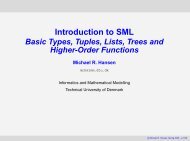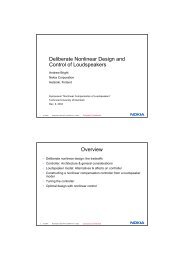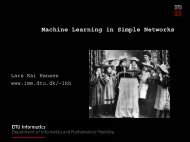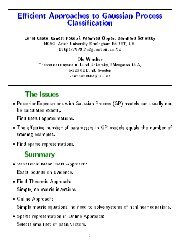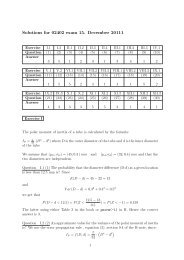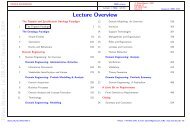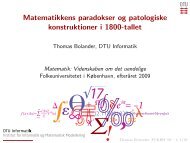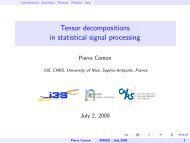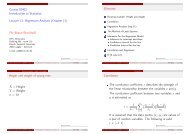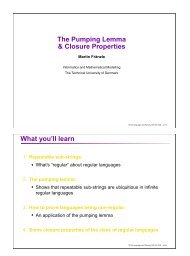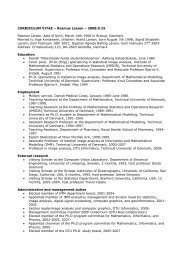Monte Carlo full waveform inversion of tomographic crosshole
Monte Carlo full waveform inversion of tomographic crosshole
Monte Carlo full waveform inversion of tomographic crosshole
You also want an ePaper? Increase the reach of your titles
YUMPU automatically turns print PDFs into web optimized ePapers that Google loves.
<strong>Monte</strong> <strong>Carlo</strong> <strong>full</strong> <strong>waveform</strong> <strong>inversion</strong>MethodologyConsider that the subsurface can be represented by adiscrete set <strong>of</strong> model parameters, m , and that a data set,d , <strong>of</strong> indirect observations <strong>of</strong> the model parameters isprovided. The model parameters describe some physicalproperties <strong>of</strong> the subsurface that influences the dataobservations. Hence, the forward relation between themodel parameters (i.e. the model) and the data observationscan be expressed as (e.g. Tarantola, 2005):d = g( m ), (1)where g is a linear or non-linear mapping operator which<strong>of</strong>ten relies on a physical law. Here, the forward relation inequation (1) is given as a finite-difference time-domainsolution <strong>of</strong> Maxwell’s equations. However, any numericalwave propagation modelling strategy for GPR or seismicsignals can be applied. The inverse problem is to inferinformation about the model parameters based on a set <strong>of</strong>observations, a priori information about the model, and theforward relation between the model and the dataobservations.In a Bayesian formulation the solution to the inverseproblem is given as an a posteriori probability density,which can be formulated as (e.g. Tarantola, 2005):σ ( m) = kρ( m) L( m ), (2)MMwhere k is a normalization constant, ρM( m)is the a prioriprobability density, and L( m)is the likelihood function.ρ ( ) Mm describes the probability that the model satisfiesthe a priori information. L( m)describes how well themodelled data explains the observed data given a datauncertainty. Hence, the a posteriori probability densitydescribes the probability that a certain model is a solutionto the inverse problem.A highly nonlinear inverse problem refers to the case wherethe a priori probability density is far from being Gaussianor the forward relation between the model and data are farfrom being linear. In the case <strong>of</strong> <strong>full</strong> <strong>waveform</strong> <strong>inversion</strong>the forward relation is expected to be highly nonlinear.Moreover, the a priori information described by a trainingimage is highly non-Gaussian.The extended Metropolis algorithm is a versatile toolwhich, in particular, is useful to obtain samples fromsolutions to non-linear inverse problems using arbitrarilycomplex a priori information. The minimum requirement <strong>of</strong>the algorithm is; 1) a “black box” algorithm that is able tosample the a priori probability density and, 2) a “black box”algorithm that is able to compute the likelihood for a givenset <strong>of</strong> model parameters. The flowchart <strong>of</strong> the extendedMetropolis algorithm is as follows: 1) The a priori samplerproposes a sample, mpropose, from the a priori probabilitydensity, which is a perturbation <strong>of</strong> a previous acceptedmodel, m accept. 2) The proposed sample is accepted with theprobability (known as the Metropolis rule):Paccept⎛ L( m ) ⎞propose= min 1,⎜L( accept) ⎟⎝ m ⎠3) If the proposed model is accepted, mproposethe a posteriori probability andOtherwisempropose(3)is a sample <strong>of</strong>mproposebecomes maccept.is rejected. 4) The procedure iscontinued until a desirable number <strong>of</strong> models have beenaccepted.In this study the algorithm that provides the a prioriinformation is the Single Normal Equation SIMulation(snesim) algorithm, which is a fast geostatistical algorithmthat produces samples (conditional or unconditional) froman a priori probability density defined by a training imagefor a relatively low number <strong>of</strong> categorical values (Strebelle,2002). Hansen et al. (2008) suggest a strategy termedperturbed simulation, which is capable <strong>of</strong> producingperturbations <strong>of</strong> spatial distributions using geostatisticalalgorithms. Thus, perturbed simulation serves as a “blackbox” that produces samples <strong>of</strong> a priori probability densitiesdescribed by both two-point and multiple-point statistics.The flow <strong>of</strong> this algorithm is as follows: 1) An initialunconditional sample <strong>of</strong> the a priori probability density(here defined by a training image) is provided. 2) A subarea<strong>of</strong> the sample is randomly chosen. 3) The model parameterswithin this area are set to unknown. 4) The unknown modelparameters are resimulated conditional to the rest <strong>of</strong> themodel parameters using a geostatistical algorithm (heresnesim) and a perturbation is obtained. 5) This procedure isrepeated in order to obtain multiple samples <strong>of</strong> the a prioriprobability density.The size <strong>of</strong> the perturbation area governs the exploratorynature <strong>of</strong> the Metropolis algorithm. The size <strong>of</strong> theperturbation area is chosen subjectively. In the extreme casewhere the area covers the entire model the outcome <strong>of</strong> theperturbed simulation algorithm is uncorrelated to theprevious model. Contrary, if the area only constitutes asingle model parameter, the perturbed model is highlycorrelated with the initial model. According to themetropolis rule a small perturbation area results in aproposed model that is more probable <strong>of</strong> being accepted ascompared to a proposed model obtained using a largerperturbation area. Therefore, the perturbation area shouldSEG Expanded abstracts



